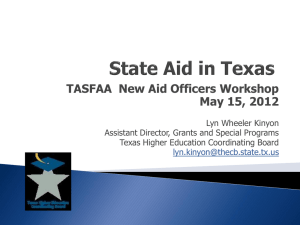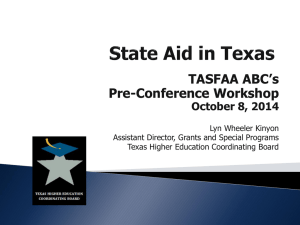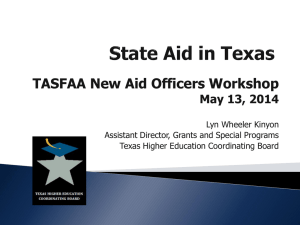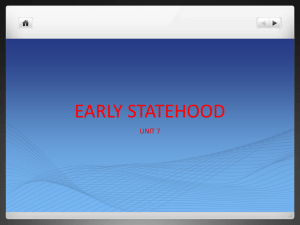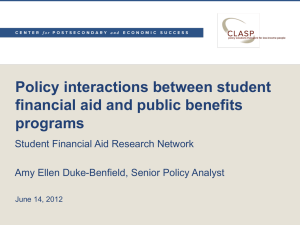Financial Aid for Texas Students
advertisement
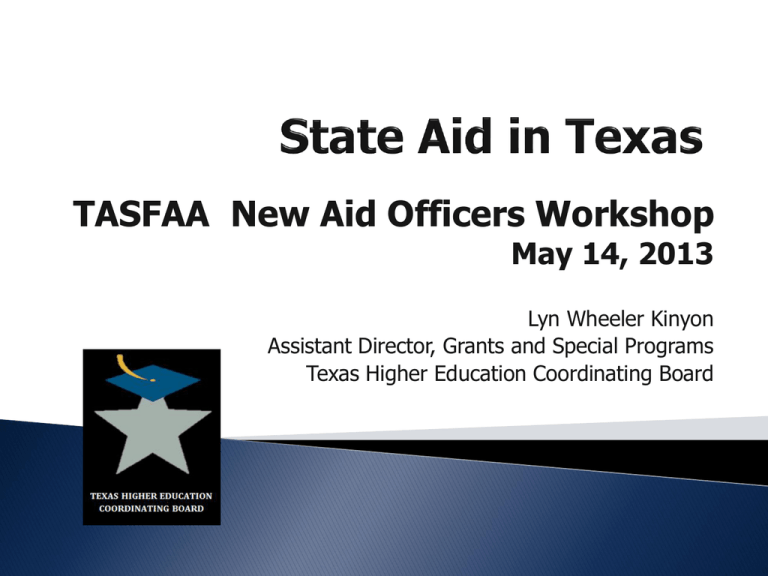
TASFAA New Aid Officers Workshop May 14, 2013 Lyn Wheeler Kinyon Assistant Director, Grants and Special Programs Texas Higher Education Coordinating Board • Created by the Texas Legislature in 1965 • Purpose: • Provide leadership and coordination for the Texas higher education system. • Responsibilities: • Assess the state of higher education in Texas; • Develop recommendations to the Legislature, Governor, and institutions for its enhancement; and • Establish policies for the efficient and effective use of the state’s higher education resources. 2 • • Workforce, Academic Affairs and Research • Academic Affairs and Research • Planning and Accountability • P-16 Initiatives Finance and Administration Business and Support Services • • Business Office • Grants and Special Programs (G&SP) * • Loan Programs Operations (LPO) * • Information Technology • Human Resources * Main areas that work closely with colleagues in the financial aid community. 3 • Provide customer service to students, families, and institutions. • Interpret legislation and develop rules. • Allocate available funding and process funding requests. • Process applications, collect student loan payments and process benefits. • Perform program reviews and audits. • Collect and provide information requested by the Legislature. • Provide training. 4 • Legislature passes a statute authorizing a program. • Legislature appropriates funds for the program – or not. • THECB writes & adopts rules – if applicable. • Programs are administered as: • Decentralized (Campus-Based) - CB allocates funding, applications submitted through the institution, institution selects recipients, CB supplies funding, and the institution submits reports to the CB. • Solely at the institutional level - applications submitted through the institution, institution determines eligibility, and CB supplies no funding. • Centralized (CB-Based) - applications submitted to the CB, CB determines eligibility, and CB notifies institution of award. 5 Grant, Scholarship, Loan, and Work Programs As Well As Exemption Programs Lower or exempt tuition and/or fees for certain groups of eligible students Waiver Programs Lower or waive tuition rates for non-resident students 6 Institutional 11.6% Federal $6,877,062,284 State $566,443,800 Institutional $1,074,292,928 Other $747,028,594 Total $9,264,827,606 Other 8.1% State 6.1% Federal 74.2% 7 • Eligible institutions: • Are defined in statute. • Have signed agreements/MOU’s with the CB. • Administer programs via state statutes and CB rules. • Complete required funding processes and reports. • Are subject to audits and program reviews. • Shadowing of Federal Processes: • Federal Methodology (FM) via FAFSA or TASFA. • Verification. • Satisfactory Academic Progress (SAP). 8 • Effective beginning with the 2013-14 application period. • Aids in consistency of information and prioritizing limited funding. • • Required at the General Academic Teaching Institutions or GATI’s (public universities, Lamar-Orange, and Lamar-Port Arthur) implementation encouraged at all institutions. Institutions have the flexibility to define what it means to meet the deadline – except for the Top 10 Percent Scholarship Program which is defined in rule. 9 • Provide grants to academically-prepared needy students at public institutions • Funded through appropriations and gifts • Eligibility: • Initial year (IY) “basic” eligibility requirements. • Initial year (IY) “priority model” eligibility requirements. • Renewal year (RY) or continuation eligibility requirements. 10 • Undergraduate student enrolled at least ¾-time who: • graduated from an accredited high school in Texas with the recommended or higher curriculum and enrolls within 16 months from graduation having not accumulated more than 30 SCH’s (excluding credits for dual enrollment or by examination); • earned an associate’s degree from a non-profit institution in Texas and enrolls in a baccalaureate program within 12 months; or • enlisted in military service within 12 months of graduation from an accredited high school in Texas with the recommended or higher curriculum May 1, 2013 or later and enrolls in a General Academic Teaching Institution within 12 months of being honorably discharged from the service. • • • • Classified as a Texas resident by the institution. Registered with Selective Service, or exempt. Has a need and a 9 month EFC < 4,620 (FY14). Has no controlled substance conviction. 11 • Beginning with 2013-14, students at General Academic Teaching Institutions (GATI’s) must meet the following for priority consideration: • Meet the basic IY eligibility requirements. • Meet the state priority deadline. • Meet the requirements in at least 2 of the following 4 areas: • AREA REQUIREMENT(S) Advanced Academic Program 12 hours of college credit (dual credit or AP courses), complete the Distinguished Achievement Program (DAP), or complete the International Baccalaureate Program (IB). TSI Readiness Meet the Texas Success Initiatives (TSI) assessment thresholds or qualify for an exemption. Class Standing Graduate in the top one/third of the HS graduating class or have a B average. Advanced Math Complete at least one math course beyond Algebra II. Any balance of allocated IY funds can go to those who meet the basic requirements after priority students have been awarded. 12 • Received an Initial Award in a Prior Year • Same as IY - Enrollment, SSR, Residency, Controlled Substance • Different than IY: • Calculated Need – no EFC cap for RY awards • GPA: • End of 1st year – institution’s SAP policy . • End of subsequent years – overall GPA of 2.5. • Completion Rate: • End of 1st year – institution’s SAP policy. • End of subsequent years – 75% annual completion rate and 24 SCH’s completed annually. • Maximum Time Frame (whichever comes first): • Receipt of a baccalaureate degree, 150 SCH’s attempted while receiving the grant, or 5 years for 4-yearr plan/6 years for 5-year plan. 13 • Provide grants to needy students at public 2-year institutions. • Funded through appropriations. • Initial (IY) eligibility requirements: • Entering undergraduate not receiving a TEXAS Grant. • Texas resident with need, an EFC < 2,000, and enrolled at least ½ time. • Registered with Selective Service (or exempt). • No controlled substance conviction. • Renewal (RY) eligibility requirements: • Calculated need. • End of 1st year – institution’s SAP policy • End of subsequent years – overall GPA of 2.5 and 75% annual completion rate. • Eligibility ends with receipt of an associate’s degree, 75 SCH’s attempted while receiving the grant, or 4 years – whichever comes first. 14 • Provide grants to needy students at private/non-profit institutions. • Funded through appropriations. • Eligibility requirements: • Texas resident or National Merit Finalist with need and enrolled at least ¾-time. • Undergraduate (UG) or graduate (GR) student working on first UG or GR degree not leading to ordination or licensure to preach. • Registered with Selective Service (or exempt). • Not concurrently receiving an athletic scholarship. • Required to pay more tuition than is required at a comparable public institution. • Eligibility continuation: • End of 1st year – institution’s SAP policy • End of subsequent years – overall GPA of 2.5, 75% completion annual completion rate, and 24 hrs per year UG and 18 hrs per year GR. • Eligibility ends for UG – 5 years for a 4-year degree, or 6 years for 5-year degree. No limit for GR. 15 • Provide grants to needy students at public institutions. • Funded through statutory tuition set-asides. • Eligibility requirements: • Financial need • Register with Selective Service or be exempt (not required of community colleges) • Awarded based on institution’s policies and procedures. • Eligibility continuation: • Renewal awards occur at the institution’s discretion • No statutory end to student eligibility 16 • Encourage outstanding high school graduates in the top 10 percent of their class to attend a public institution in Texas. • Funded through appropriations. • Initial (IY) eligibility requirements: • Texas resident. • Complete Recommended or higher curriculum and graduate from a public or private accredited high school in Texas. • Rank in the top 10 percent of the HS graduating class. • Submit the FAFSA in time to generate the CPS results in a non-rejected status, or submit the TASFA to the institution, by the priority deadline . • Meet need component (COA – EFC – PELL > $0). • Registered with Selective Service (or be exempt). • Enroll full-time in the fall semester and maintain full-time enrollment through the census date of the semester. 17 • Renewal eligibility requirements: • Submit the FAFSA in time to generate the CPS results in a non-rejected status, or submit the TASFA to the institution, by the established deadline . • Meet need requirement (COA – EFC – PELL > $0). • Enroll full-time in the fall semester and maintain full-time enrollment through the census date of the semester. • Maintain a cumulative 3.25 GPA, complete at least 30 SCH in the previous year, and complete at least 75% of the hours attempted in the previous year. • Eligibility ends with a Bachelor’s degree or 4 years – whichever comes first. • Workforce bonus eligibility requirements: • Major in critical workforce shortage area and enroll as a junior or senior. • Have overall GPA of 3.0 at the beginning of the relevant junior or senior year. 18 • • • Provide eligible Texas students no-interest loans and loan forgiveness upon graduation for meeting specific goals. Funded through appropriations and tuition set-asides from 4-year public universities. Eligibility requirements: • • Eligibility continuation: • • • • Texas resident enrolled full-time and eligible for federal aid. End of 1st year – institution’s SAP policy. Thereafter, overall GPA of 2.5; 75% completion in the most recent year. Eligibility ends with completion of a baccalaureate degree or 150 attempted hours while receiving the loan. Repayment benefits: • • loan forgiveness if graduation time frame, GPA, and number of hours are within program guidelines. 0% interest loan if not eligible for forgiveness. 19 • Provide alternative loans to Texas students who are unable to meet the cost of attendance at public and private/non-profit institutions. • Funded through the sale of state bonds. • Eligibility requirements: • Texas resident enrolled at least ½-time. • Receive a favorable credit evaluation or provide an eligible cosigner who has a favorable credit standing. • Meet the institution’s SAP policy. 20 • • • Provide eligible Texas students employment as a means to fund their education at public and private institutions. Funded through appropriations and subject to matching by employer (unless proof is provided that matching is waived for FCWS). Eligibility requirements: • • • • Texas resident with financial need and enrolled at least ½-time. Registered with Selective Service (or exempt). Not receiving an athletic scholarship. Not enrolled in a seminary or other religious program. 21 • Numerous Exemption Programs (examples): • Hazlewood • Peace Officers • Fire Fighters • Valedictorian • Numerous Waiver Programs (examples): • Competitive Scholarship Waiver • Military • Teaching and Research Assistant • Scholarships (examples): • Kenneth Ashworth Scholarship • Good Neighbor Scholarship Complete Listing: http://collegeforalltexans.com/ 22 Direct Contact Information: lyn.kinyon@thecb.state.tx.us 512.427.6393 or 800.242.3062 x6393 General Contact Information : grantinfo@thecb.state.tx.us 512.427.6340 or 800.242.3062 General Website: www.collegeforalltexans.com G&SP Site: https://www1.thecb.state.tx.us/apps/SpecialPrograms/ Distribution List: http://lists.state.tx.us/mailman/listinfo/txgnsp-l 23 24
